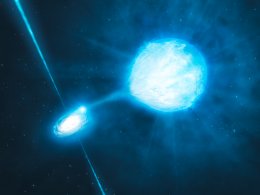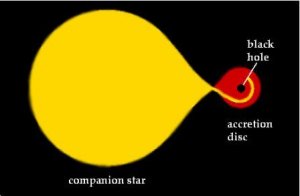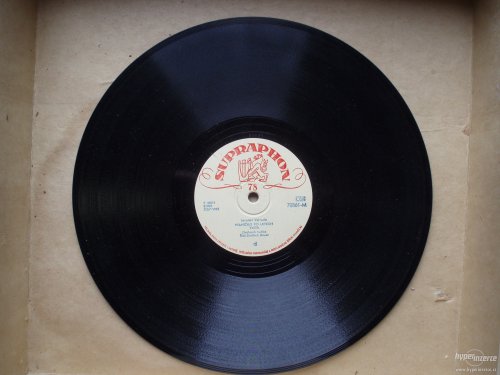What is an accretion disk?

Accretion disk are crucial tools for our study of black holes. Almost everything we have learned about black holes we learned thanks to accretion disks. Why? One thing that had changed astronomy from ground was when people realized that there was more to see in the universe than what optical telescopes had until then allowed them to see. They discovered that the visible light was only a small fraction of the whole electromagnetic spectrum and that information travel through universe on many wavelengths from radio, through microwave, infrared, optical, ultraviolet, X-ray, to gamma rays. Since then, everything we know about the universe we have learned from electromagnetic radiation. Black holes, however, do not produce any radiation and that would make them impossible to study if they did not have accretion disks around them. Those disk are what we actually observe and from what we infer properties of their central gravitating objects.
Accretion and accretion disks
Accretion is a process of a growth of a massive object by gravitationally attracting and collecting of additional material. Typically, this happens through a disk-like structure of diffuse material or gas that is in orbital motion around the central accreting object. Accretion disks are ubiquitous features in the universe and can be found around smaller stars or stellar remnants, in close binary stars, in the centers of spiral galaxies, in quasars, they form also in gamma-ray bursts.
 Accretion can have many forms. It can be spherical, or planar. It can be persistent or episodic. The usual scenario for accretion is that the material flows from one celestial object to another. Then there exist a preferred direction given by the orbital plane of the two bodies. The flow also keeps that plane, but does not extend straight from one object to the other since it has some angular momentum from the orbital motion of the two. It is pushed little bit aside by Corriolis force and forms a disk around the target object.
Accretion can have many forms. It can be spherical, or planar. It can be persistent or episodic. The usual scenario for accretion is that the material flows from one celestial object to another. Then there exist a preferred direction given by the orbital plane of the two bodies. The flow also keeps that plane, but does not extend straight from one object to the other since it has some angular momentum from the orbital motion of the two. It is pushed little bit aside by Corriolis force and forms a disk around the target object.
This way the material piles up in a dense spinning accretion disk orbiting a black hole, star or other gravitating object. Friction between adjoining layers causes the gas in the disk to heat up as its potential energy is slowly dissipated into heat. The gas also loses angular momentum which allows it to get closer to the central object and orbit faster. Faster motion results in more friction and as the gas gets very hot it radiates out energy. It depends on the mass of the central object what temperature the disk can reach, the massive it is the lower temperature the disk has. Disks around stellar-mass black holes have temperatures around millions of Kelvins and radiate in X-rays, disks around supermassive black holes have temperatures around thousands of Kelvins and radiate in optical or ultraviolet light.
How to imagine an accretion disk

We can imagine an accretion disk like an old good gramophone record. Surprisingly it has many features of an accretion disk. When we start playing the record, we position the needle at the outer edge of the disk. That is also where the matter enters the accretion disk - at its periphery. The needle than follows a very tight spiral groove as the vinyl plate runs underneath and the music is being played. You can see the needle to drift very slowly towards the center of the plate while it goes around the plate many many times. Same with accretion disk. A matter particle that has entered the disk must loose its angular momentum. While it does so by exchanging it with other particles around, it keeps running around many many times along a Keplerian orbit like a planet around the Sun.
The gramophone record can play for 45 minutes, it takes the matter weeks or years (depending on the size of the disk) to drift from outside to its inner edge. Once the record is finished and the needle reaches the end of the track, the spiral groove unwinds quickly which places the tonearm to a position to stop. In black hole accretion disks, a similar thing happen. We stress it must be accretion disks around black holes here, because this effect is a relativistic one and does only manifest itself in a sufficiently strong gravitational field around compact objects like black holes or perhaps neutron stars. What happens is that at a certain radius, already quite near the central black hole, matter particles can no longer orbit along circular Keplerian trajectories. Such trajectories cease to be stable due to effects of general relativity and from that moment on, the particle is on a free-fall open spiral that is going to lead it through the rest of the way down to the event horizon within few orbits at speed close to speed of light, where it ends its long way.
The existence of that special feature in the disk where stable Keplerian trajectories do not exist turns out to be of a very high significance. Since matter can peacefully orbit in the disk everywhere outside this special place but not inside, it means that the disk turns out to have 'hole' in itself. The size of this hole depends on the properties of the central black hole (its mass and rotation) only. Therefore, if we managed to measure the size of the hole, we could infer properties of the black hole itself. How exciting! And indeed, astronomers have come out with a handful of ideas of how to do exactly that.

